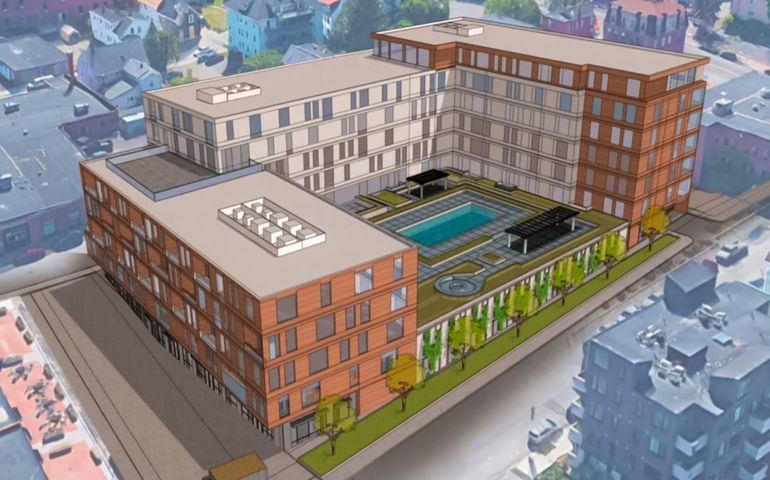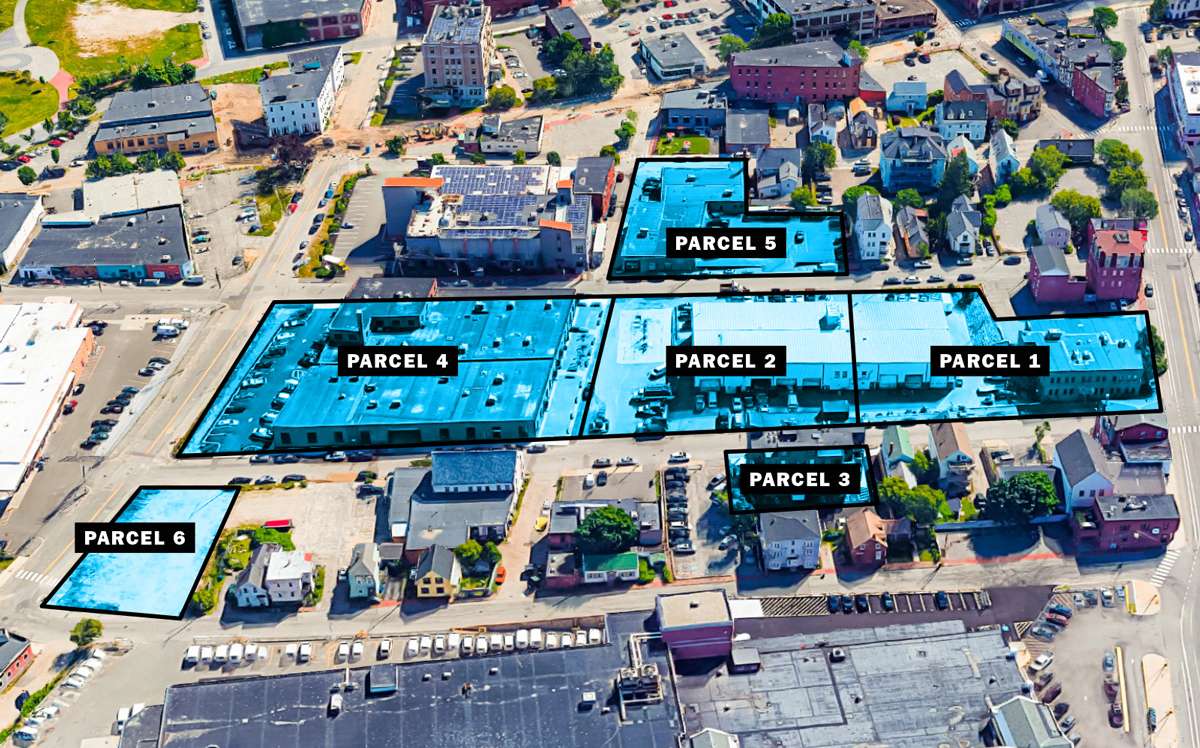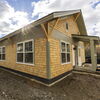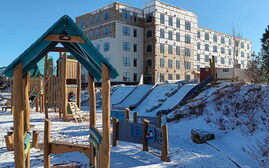
Final piece of a Portland redevelopment puzzle may also be the most ambitious
 courtesy / 3cube
A rendering of the planned mixed-use building at 52 Hanover St.
courtesy / 3cube
A rendering of the planned mixed-use building at 52 Hanover St.
A 239,000-square-foot mixed-use building planned for 52 Hanover St. in West Bayside, Portland, is the last and most ambitious piece of a four-year effort that has transformed several blocks that were the former public works depot.
The 171-apartment building, which will also have 6,500 square feet of retail space, is the final of six city public works department properties listed by the city in April 2017 to be redeveloped.
Tom Watson, of Port Property Management, had already developed another of the public works properties, 82 Hanover St., into a mixed-use building that includes restaurants, bars and office space. He originally planned 16 units of maker space for the 8,435-square-foot maintenance garage at 52 Hanover, but once the neighborhood started to take shape, so did the vision for the property.
The vision was much bigger than maker space.
When the Portland Planning Board gave the go-ahead to the project in late March, nothing of that scale had been approved since the 440-apartment, retail and hotel Midtown project planned for nearby Somerset Street in 2015. That project was never built.
The size of the big building on the small lot at 52 Hanover didn’t, even for a second, faze Watson.
He understands that the scale of the project may make some people nervous.
“Some folks are worried about the size,” he says. “Change is scary. I get it. But once it’s built, and people see the neighborhood change, see people on the sidewalks, they’re going to love it.
“I never saw it as big,” he says. “I said, ‘This is going to be really cool.’”

The project isn’t just unique to West Bayside, Watson says. “It’s unique to Portland.”
Spreading the risk around
The transformation of West Bayside began more than 20 years ago with a city plan that called for housing, trails and more in what had become a post-urban-renewal industrial wasteland.
The main features of the neighborhood bordered by Forest Avenue, Franklin Street, Congress Street and Interstate 295 were a vacant railroad yard, three scrap yards and the city’s Department of Public Works, which took up several blocks.
Development was slow to arrive, colored by a drawn-out back and forth over the failed Midtown project.
The city public works department planned to move to Canco Road in 2018, and as the Midtown dispute ground to its conclusion, city officials in 2017 decided to sell the parcels separately.
The city “hit the sweet spot,” with the public works property developers, says Jeff Levine, who was the city’s director of planning and urban development at the time, and now is a lecturer on economic planning and development for the Massachusetts Institute of Technology and Muskie School of Public Service at the University of Southern Maine.
“In retrospect, the best thing to happen was the decision to develop it in small pieces,” he says.
Not only did the strategy “spread the risk around,” in case one development failed, but the different development visions that complement each other have spurred organic growth in the neighborhood.
Goal of creating density
Watson says the city’s lack of affordable places to live was a factor in the decision to build the apartment complex. He’s developed more than 1,400 apartment units in the city and understands Portland’s goal of adding affordable housing.
He and his development partner, John Laliberte, said, to that end, they wanted to build as many apartment units as they were allowed to on the site.
Watson notes the height maximum is designed to allow more density in the area. “There’s a lot of opportunity to build up in Bayside,” he says. “Up is good, density in the city is good. So, we decided to go up.”
The building will range from five to eight stories, fitting in with the grade of the lot.
Levine says Watson’s 82 Hanover and Rob Barrett’s Public Works office space in the former paint and sign shop at 65 Hanover show how utilitarian buildings can be nicely reused. Still, he’s not surprised Watson’s team went in a different direction with 52 Hanover.
“It’s an indication of how strong housing demand is right now,” Levine says. He says the large-scale building works well with the neighborhood. Different size buildings make a neighborhood more interesting, he says.
A project apart
Big developments are nothing new to Port Property Management.
Current projects include redeveloping the nearby former Bayside Village redevelopment into 196 units of workforce housing, the Riverdam mill redevelopment in Biddeford and just-underway Saco-Lowell mill, also in Biddeford.
Usually, Port Property does its own construction, and it’s undertaken a number of large projects.
But 52 Hanover is different.
“The sheer scale of this development sets it apart from other Port Property projects,” Laliberte says. And, as the company’s first ground-up development, it will also be the first one with a third-party construction manager.
Watson says that the team has just started looking for one after the lengthy review process with the city staff. “We’ve just got the architectural drawings to where we want them,” he says.
The building, designed by Cube3, will also “just be really cool,” Watson says.
It will have three tiers that will help break up the mass, “so it’s not just one big building.”
Parking for residents is on the lower two floors. A grassy courtyard surrounded on three sides by the building is open to the Parris Street a story below. The courtyard will have plantings, fire pits and a water feature for residents to sit around. There will also be a bicycle storage and repair area for residents, two lobbies, one with a mezzanine.
Outside, a “living wall” of plants will liven up the exterior garage wall along Parris Street. Laliberte says it will work well with the landscape design along the Parris Street sidewalk.
Watson says, assuming a general contractor is nailed down soon, the groundbreaking will be in the fall and the building will be completed in 2023.
It’s taken a lot of work, he says, to get to this point and a development team that also includes Brian Bush, of Port Property Management, Mike Barton, of the Congress Group, Acorn Engineering, and several others.
Creating a destination
The other factor that spurred the plan for 52 Hanover was how the neighborhood is developing.
At the 82 Hanover site next door, the three bars and restaurants along Lancaster Plaza, a pedestrian walkway that was once a street between the two lots, brought a new energy to the block. Tenants Whiskey Barrel, Wilson County Barbeque and Banded Brewing all had outdoor patios on the walkway and the developers wanted to complement that across the way.
Laliberte says there was a lot of interest in the 82 Hanover space from bars and restaurants. “It sparked the idea to, essentially, capture that opportunity and that atmosphere, and create a destination by placing mirroring retail uses on the 52 Hanover property.”
Watson says the mix of residential, restaurants and retail “provides an experience that will be unique in Portland.”
Laliberte says the project, overall, is “a good fit for the neighborhood.”
“It brings 24/7 vibrance and density to an underutilized space, currently an abandoned old public works garage and surface parking lot,” he says.
Levine agrees. He says the attitude toward density, too, has changed as urban areas evolve, and that residential factor is key to sustaining downtowns.
“Twenty or 30 years ago, people believed more density downtown meant a lot of challenges, like traffic, congestion,” he says.
Now the belief is that it brings people to live in an area, who will walk, bike or take the bus to work and local businesses.
Not only do people need housing, but the city needs people living in its core, he says.
“People love quirky shops,” Levine says, but for cities to be sustainable in the age of online commerce, there has to be people nearby to shop at them. “People need to be there, you need more people living there.”
The growing vibe in West Bayside isn’t just limited to the public works properties development, Watson says. Bayside Bowl, owned by Charlie Mitchell and Justin Alfond, was the pioneer.
“They were the first, and they’ve done a fabulous job,” Watson says.
Fork Food Labs, Leavitt & Sons Deli and Northland Enterprise’s redevelopment of the former Century Tire into a retail center have all played a part.
He says the other residential developments on the former public works property — Szanton Co.’s 51-unit Furman Block and Jack Soley’s 23-condo Parris Terraces — are also great additions to the neighborhood.
“I think 52 Hanover is going to be a great complement to the others,” he says. The time has come, he adds. “West Bayside deserves it. It deserves to have people living here, the energy. It ought to be a 24/7 neighborhood.”
Mainebiz web partners
Sounds like another overpriced development that actual working class Portlanders won't be able to afford
It does sound like a great addition to Portland but covered parking is going to be critical.















2 Comments